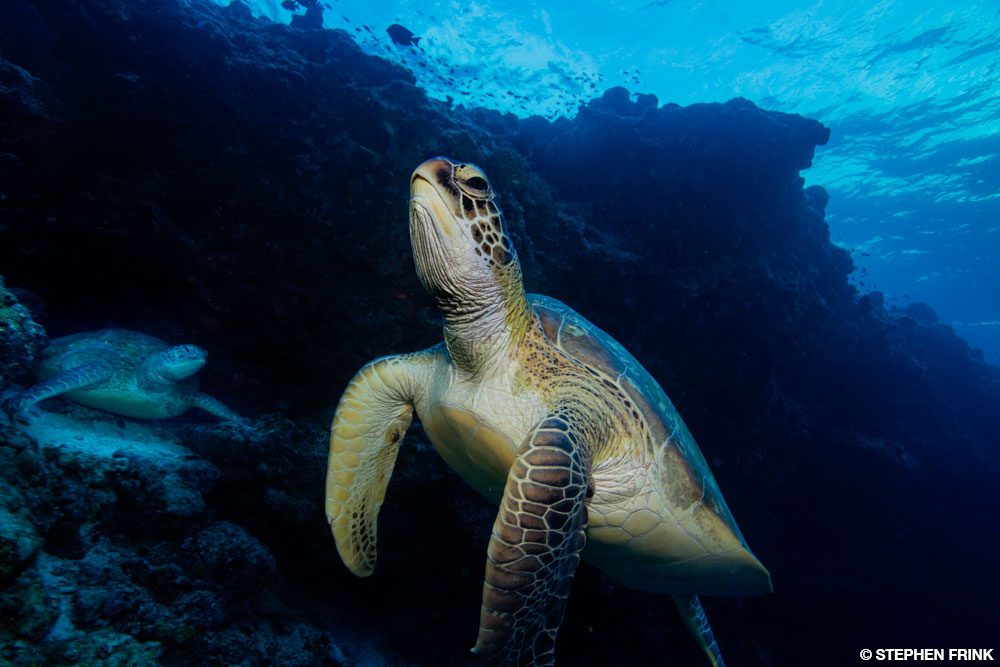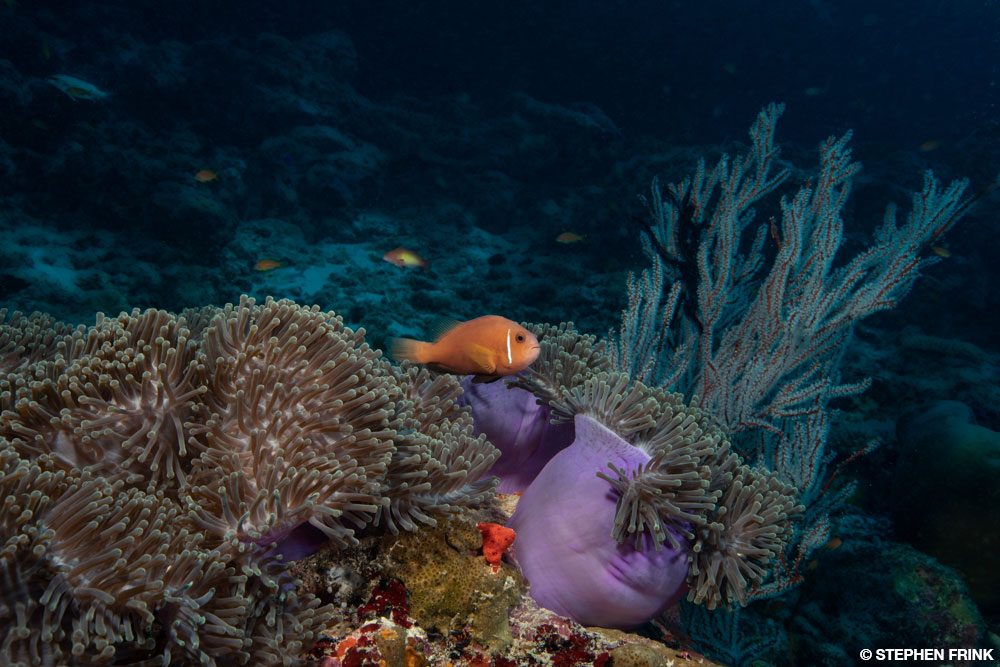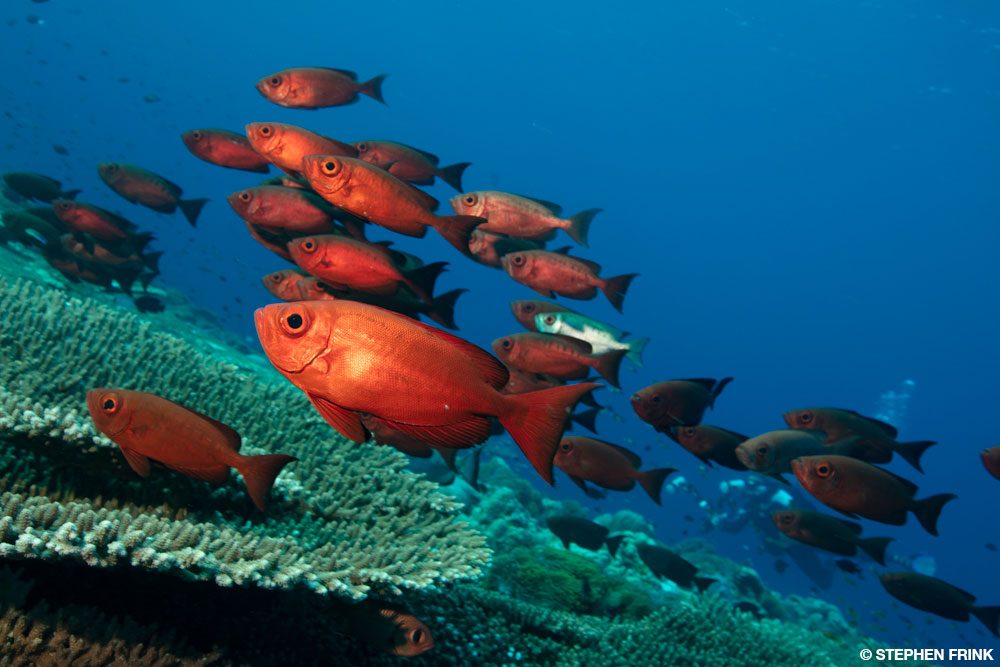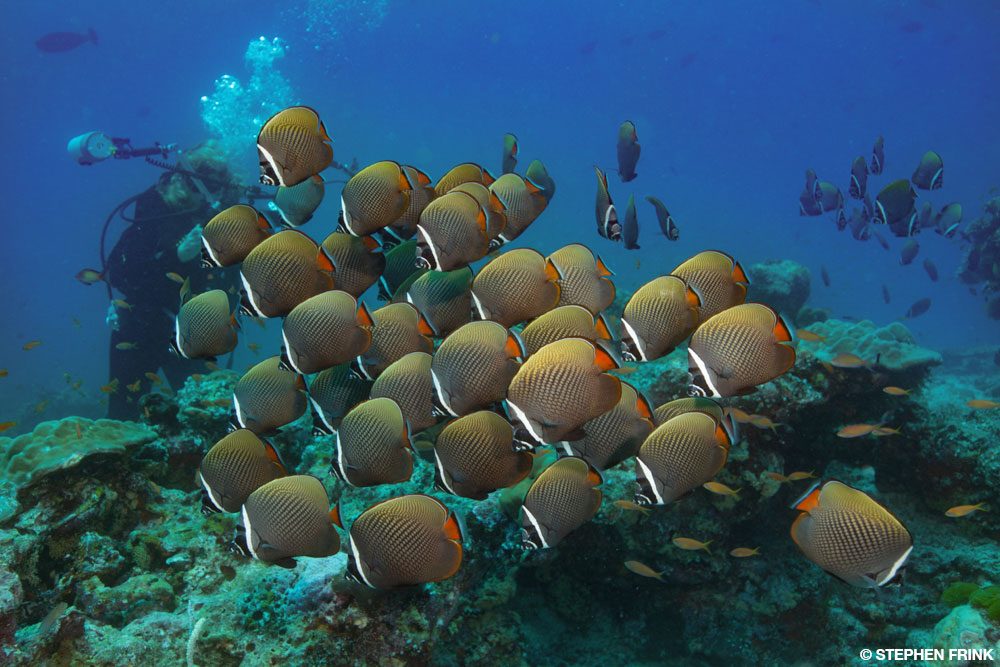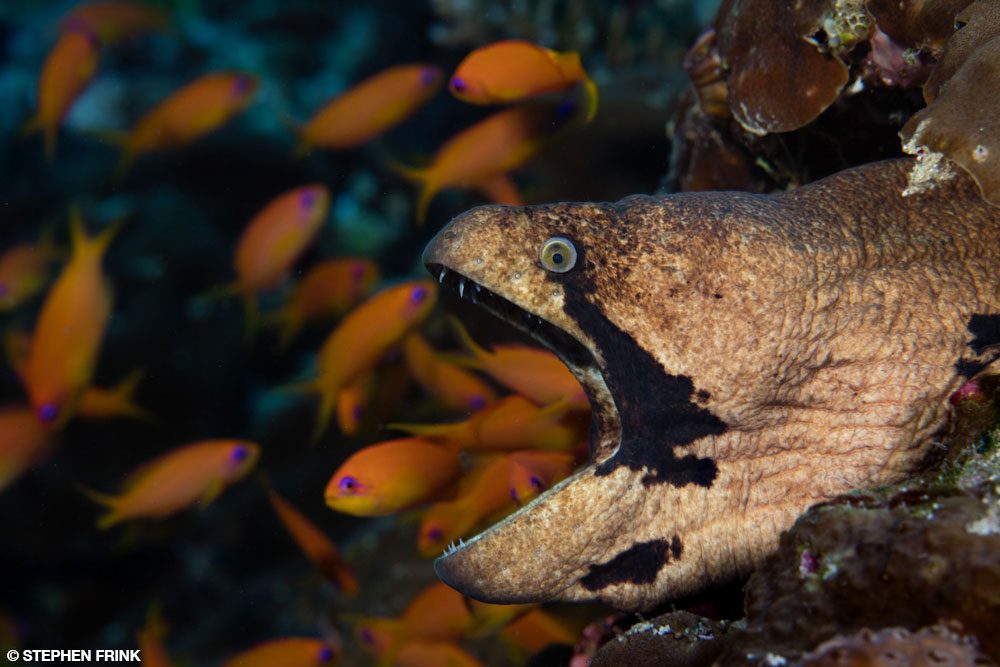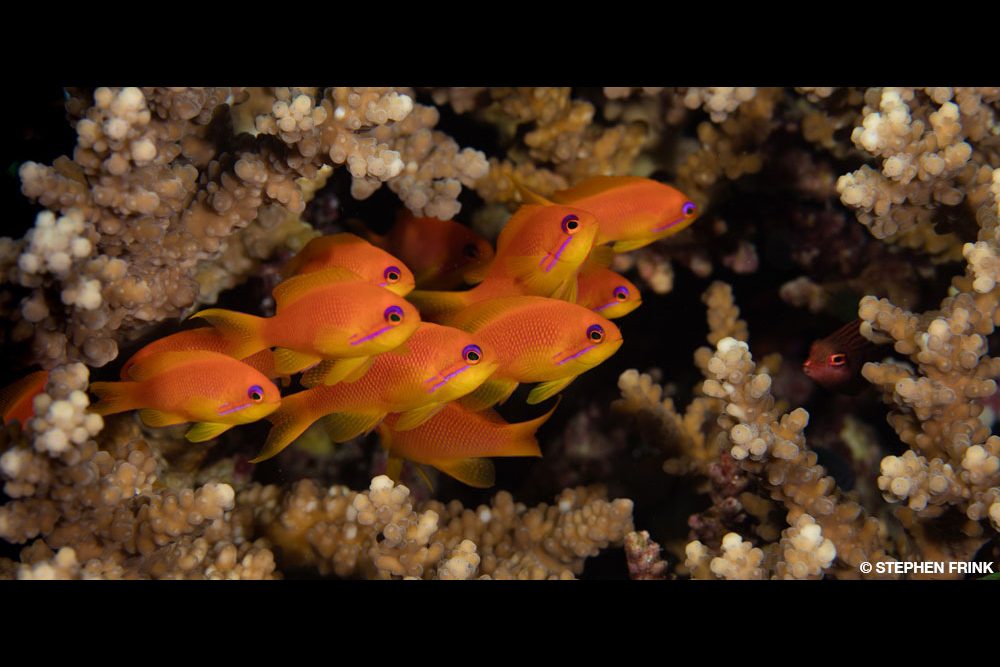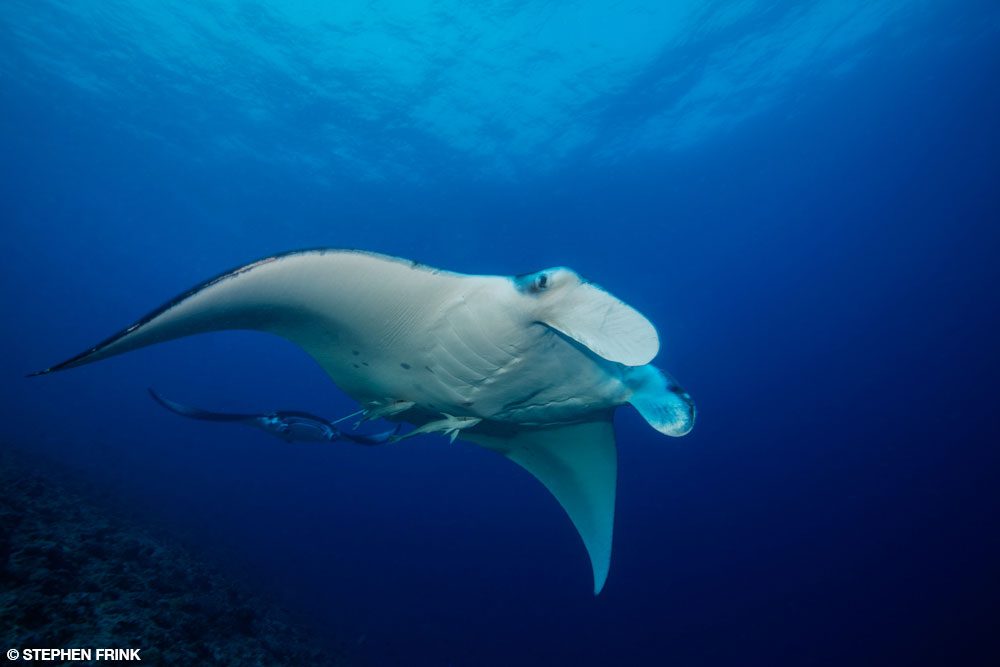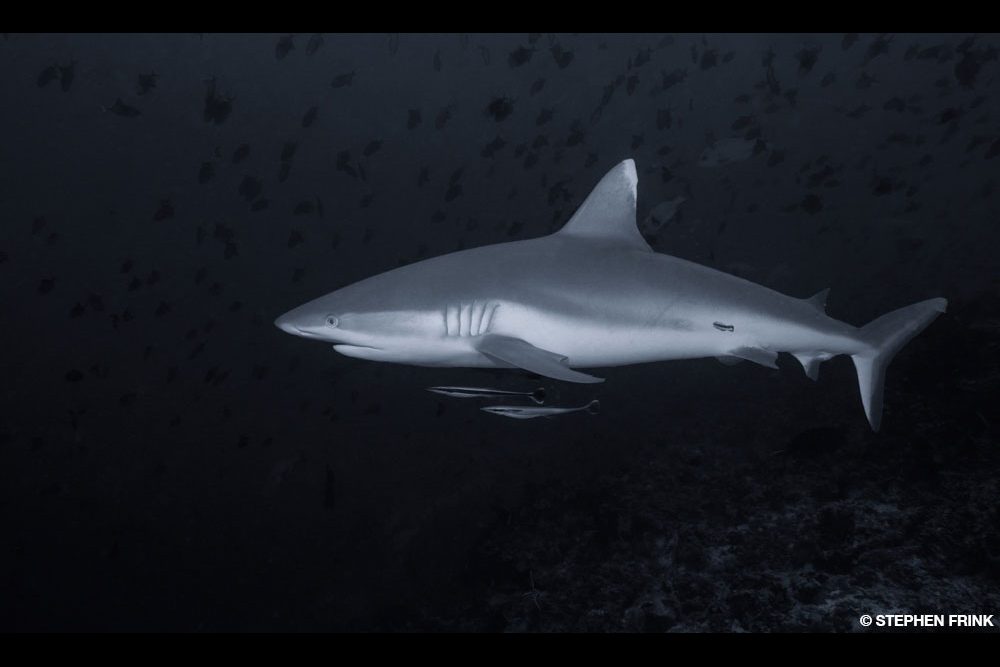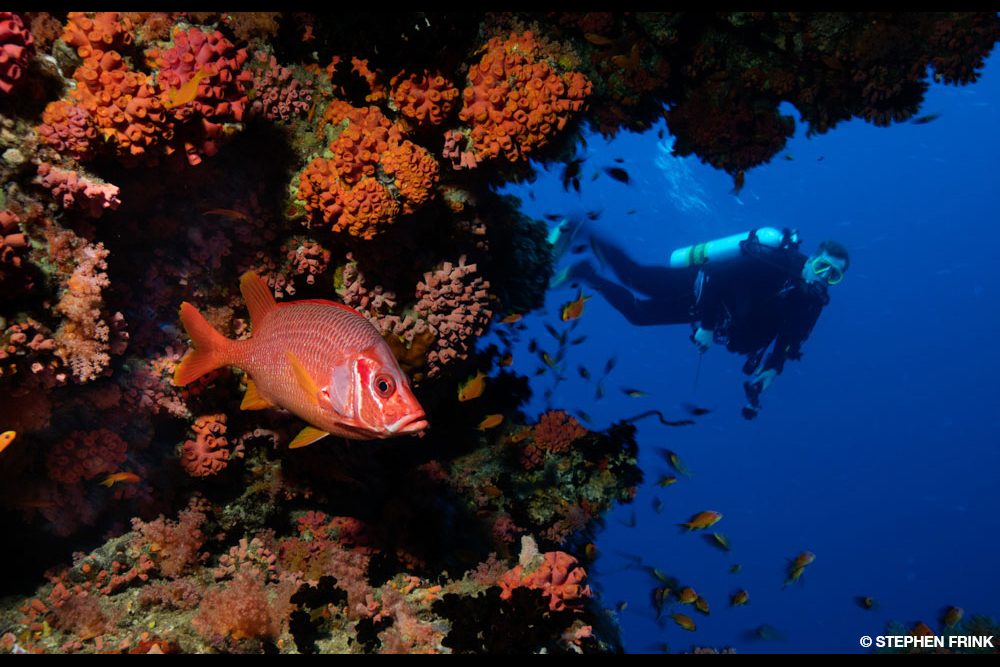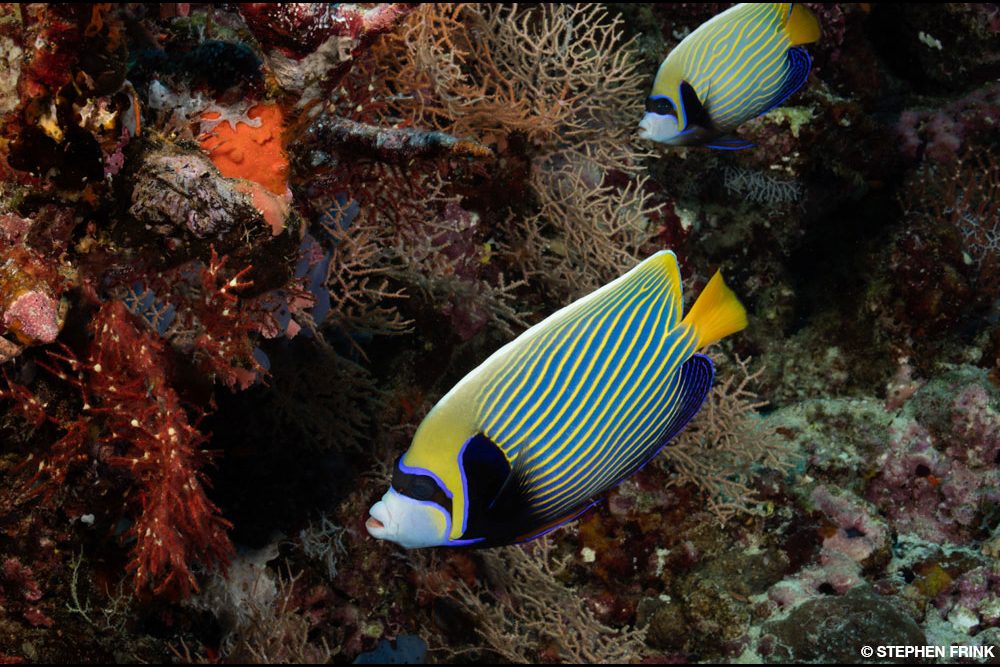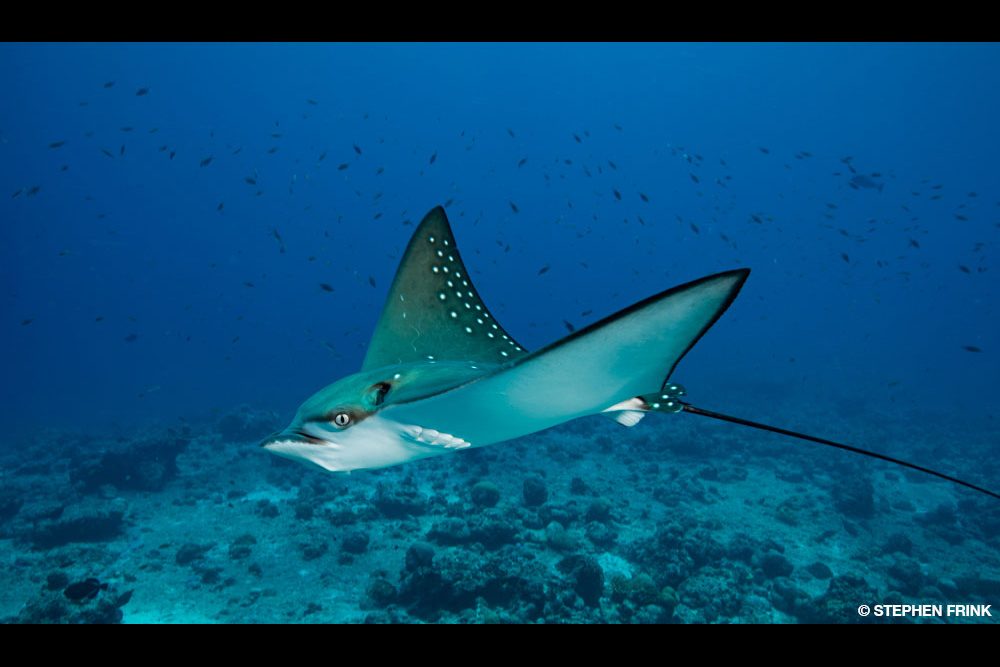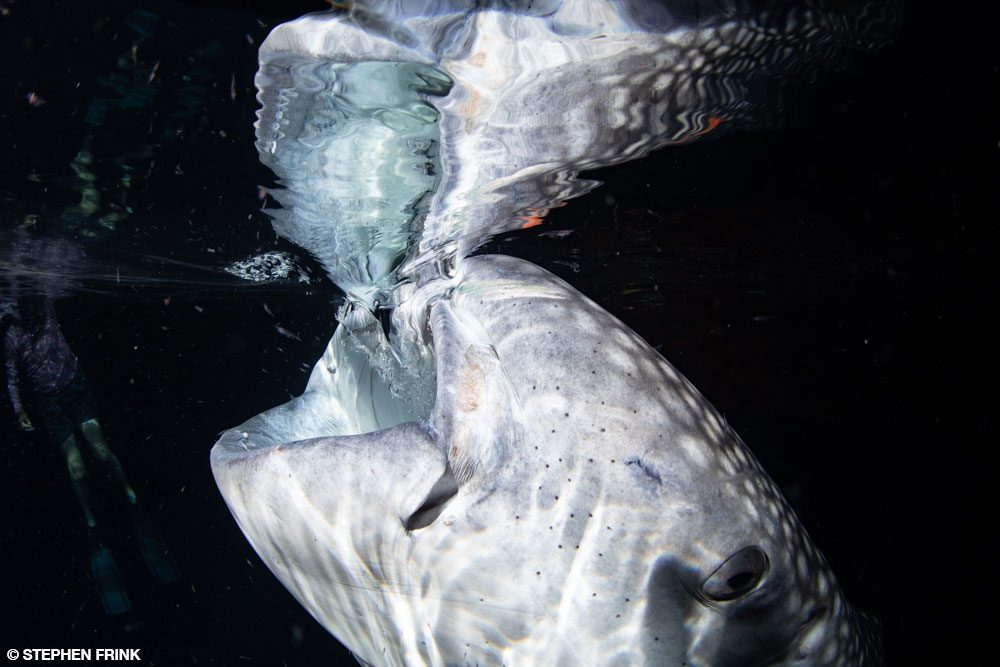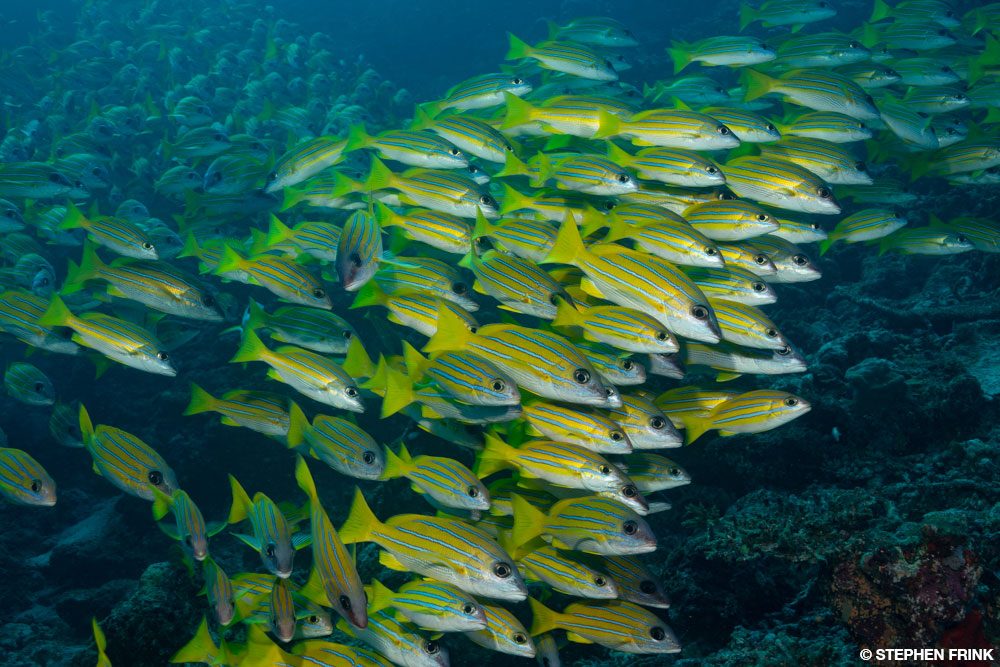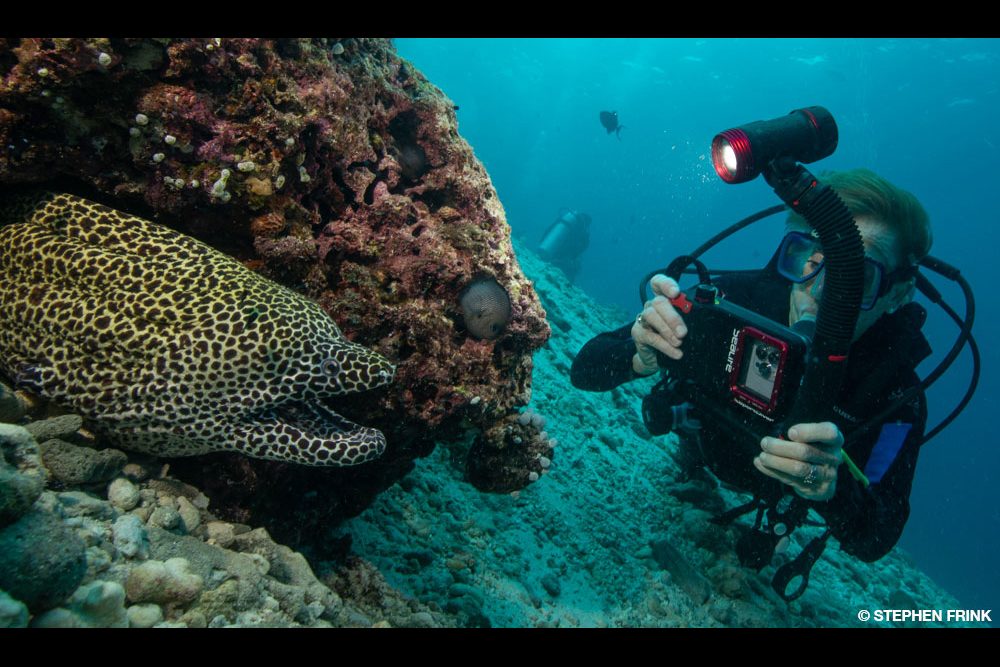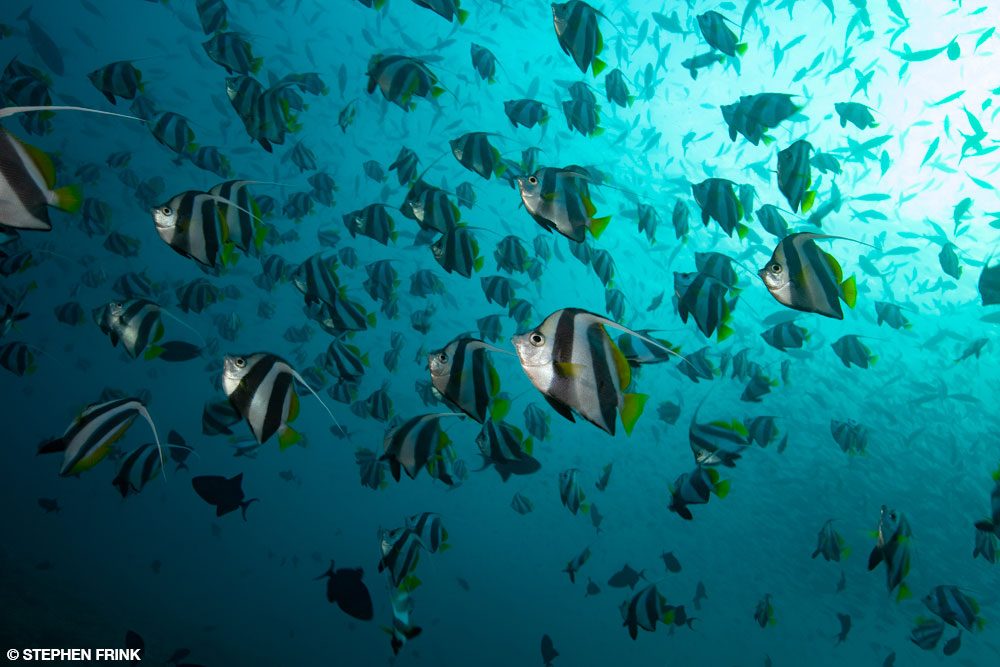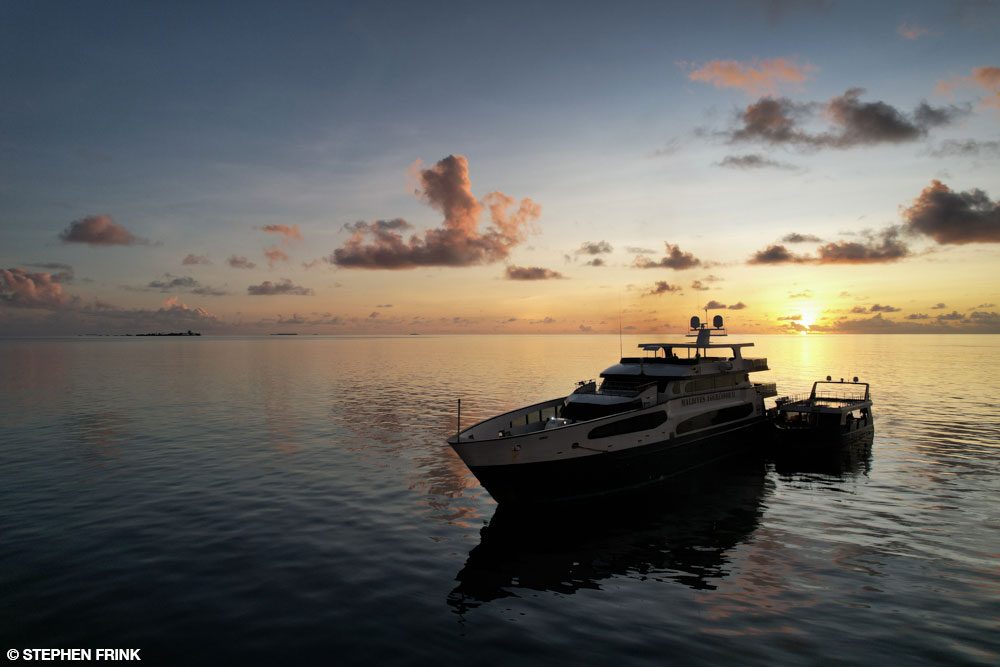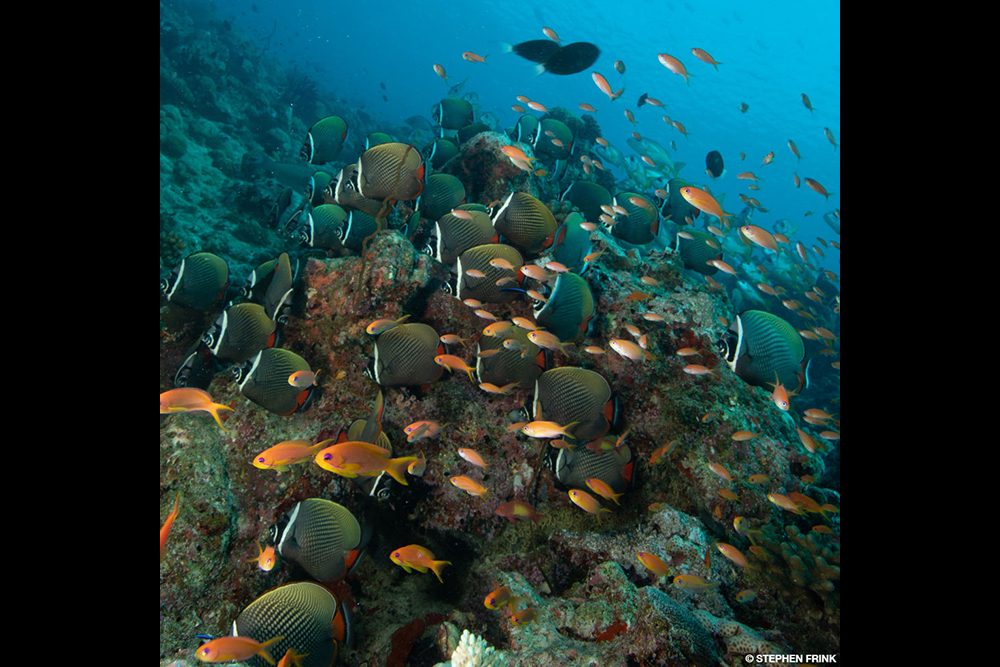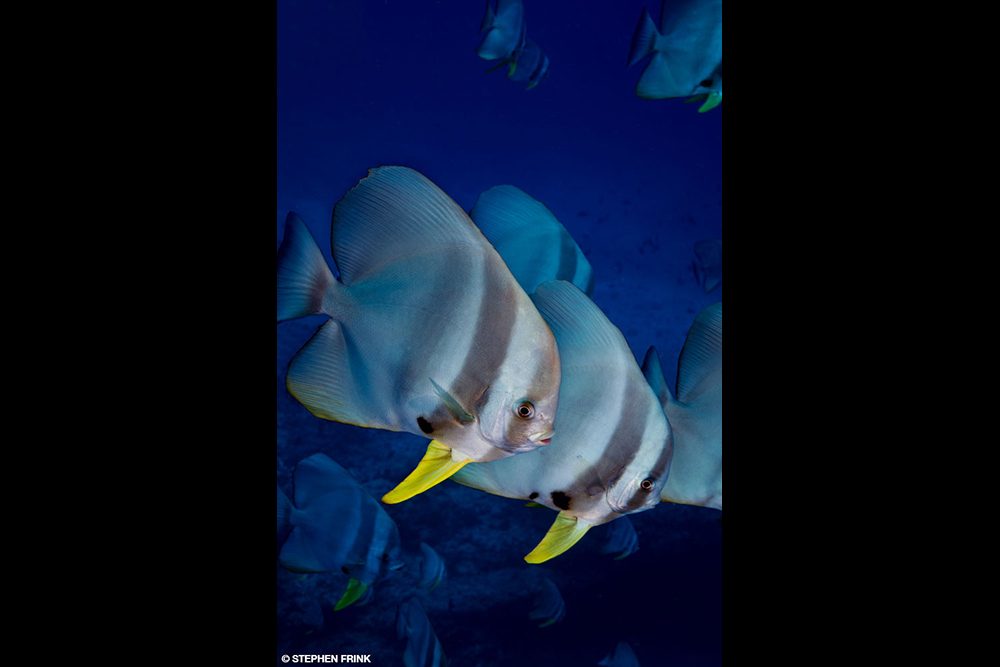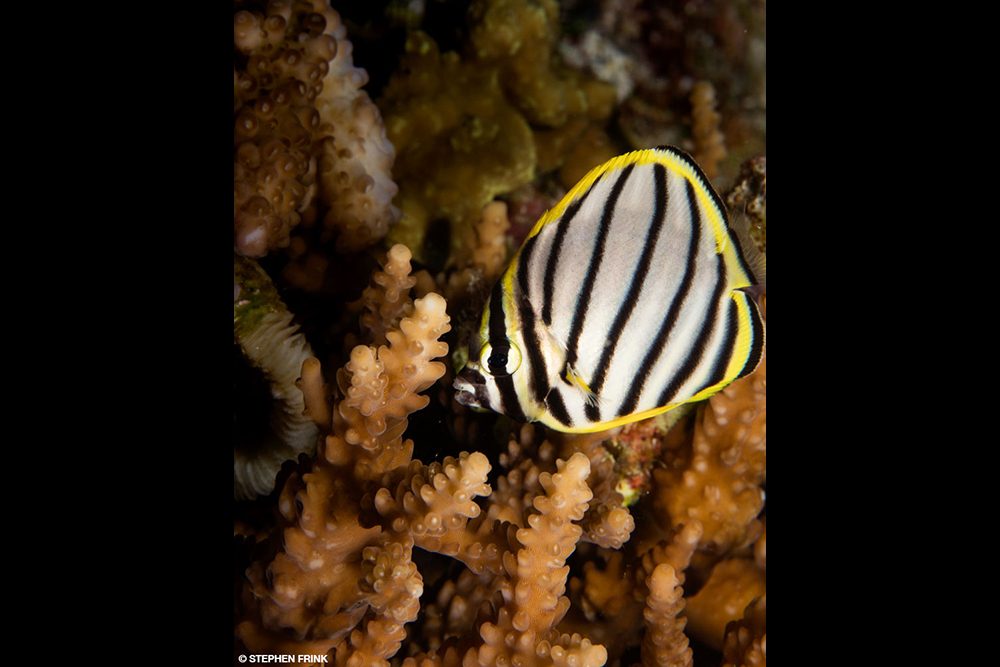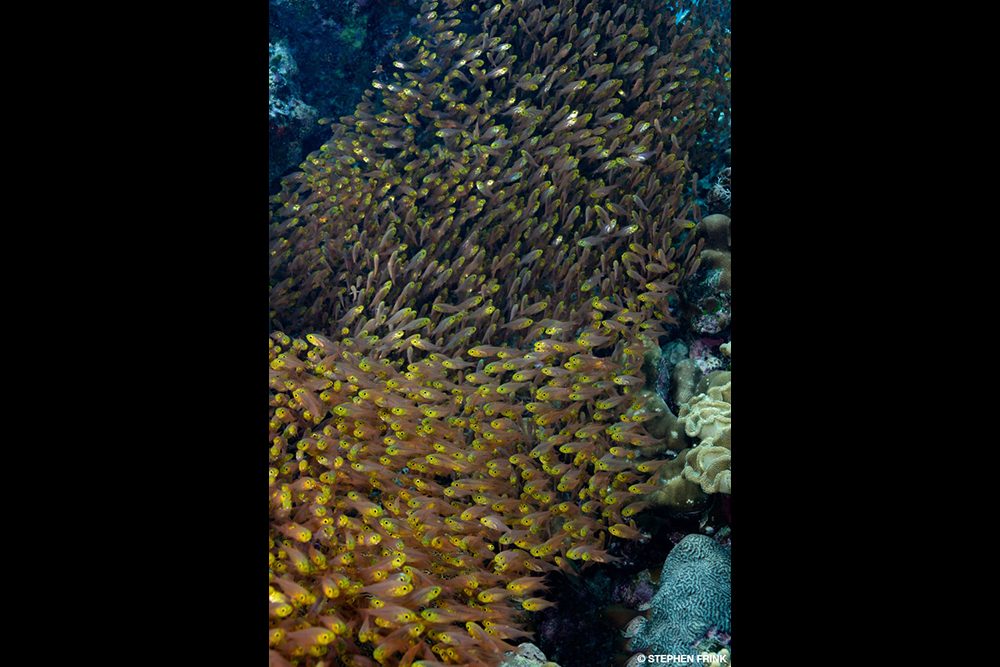Un pays des merveilles avec des mantas et plus encore
ALORS QUE LE MONDE ÉTAIT ENCORE EN GRANDE PARTIE VERROUILLÉ Malgré les restrictions de voyage, mon fil d'actualité sur les réseaux sociaux était rempli de superbes photos des Maldives. Les Maldives ont ouvert leurs portes plus tôt que la plupart des destinations de plongée à l'étranger, ce qui nous a permis de nous inspirer de nombreuses photos pour notre voyage en mai. La couverture en ligne incluait les requins-baleines, les raies manta, les requins-tigres et les récifs tropicaux colorés qui, nous l'espérions, nous attendaient.
All we had to do was get there, which was easy by exotic dive travel standards. A direct flight from Miami to Doha, Qatar, took 14 hours, and then a five-hour connection took me to the international airport in Malé, the Maldives’ capital. While that is a long time, especially factoring in the layover in Doha, it is also easy, making the Maldives more accessible than most world-class dive destinations. While Miami was convenient for me, others in our group departed from New York, Seattle, Houston, and Los Angeles. There are other U.S. and European gateways to the Maldives, which depends on tourism. Easy air access is the lubricant that keeps the wheels of commerce spinning.
From Malé, a speedboat or airplane can whisk visitors to a land-based resort on one of many white-sand-rimmed islands — there are 1,192 recorded islands in 26 atolls throughout the Maldives. As we did on this trip, you can also meet a liveaboard for one of many possible itineraries. However you do it, the dive opportunities are situated away from the capital’s congestion and amid a sea of blue. Fortunately, being away from the capital doesn’t necessarily mean a far trip — there is good diving less than a 30-minute boat ride away and throughout the archipelago.
A brief overview of the Maldives’ reef structure helps explain the dive opportunities. The Maldives feature submerged volcanic mountains, which provided the substrate for coral colonization. The low coral atolls built up atop these peaks and rising sea levels led to extensive fringing reefs. These islands are now only the very tops of submerged mountains and are in jeopardy of the sea soon (geologically speaking) subsuming them. Large apartment developments are under construction on Malé to house residents from the outer islands that are losing land, but tourism continues to thrive despite this infrastructure problem.
The diving varies according to whether you are along a channel, faru, thila, or giri. Divers generally drop in the channels between the open ocean and lagoons on an incoming tide for two reasons: It brings the blue ocean water through the channel, and an outgoing tide would sweep you into the vast ocean rather than a quiet, protected lagoon, where it’s easier and safer to reboard the dive boat.
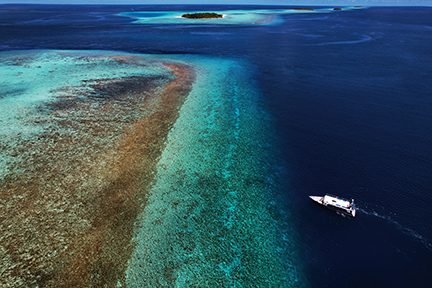
Un dhoni de plongée s'approche du récif peu profond qui fait face à l'océan Indien, tandis qu'un canal mène à une lagune protégée.
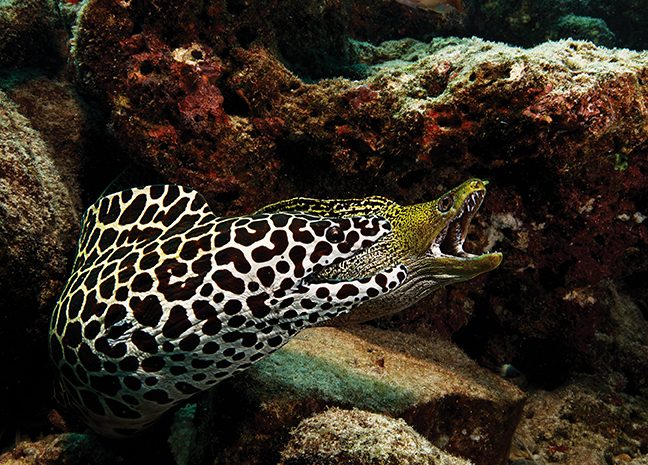
Sur le site de plongée connu sous le nom de Fish Tank, il est courant de voir des murènes de différentes espèces cohabiter dans les mêmes anfractuosités du récif.
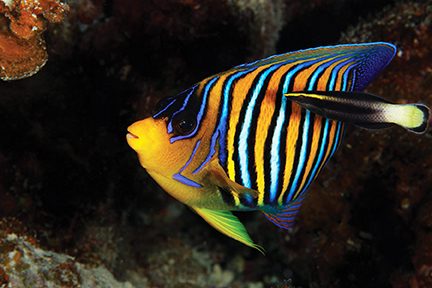
Les farus sont des récifs circulaires qui s'élèvent du fond de la mer, généralement à l'intérieur d'un chenal. Le courant et les nutriments balayant le fond à chaque changement de marée signifient qu'il y a beaucoup de bons farus avec une croissance de coraux mous. Lors d'une marée optimale, une bonne action pélagique se produit à l'endroit où le courant est le plus fort. Un thila commence dans des eaux moins profondes à l'intérieur des atolls et peut être assez petit pour être contourné lors d'une plongée. Le giri est souvent plus petit, mais ces termes sont souvent interchangeables. Tous deux n'ont pas de structure circulaire et présentent plutôt un promontoire peu profond avec une concentration de coraux.
This is relevant because the type of diving depends on the tide, where the structure is located relative to the channel, and whether it is in an area protected from the current. Our group of photographers found some of the drift dives through the channels to be unproductive. While there were plenty of things to photograph, it was hard to stop long enough to set up the shot. We often opted for a quiet reef dive instead of a high-velocity drift. The Maldives gives you plenty of options depending on the group’s preferences.
Malé is at the southern edge of Mal du Nordé AtollCette région est bien explorée et compte des dizaines de sites de plongée de qualité. En commençant notre expédition ici, nous avons laissé les bagages qui n'étaient pas arrivés sur le vol international nous rattraper alors que nous étions encore près de l'aéroport.
Il est possible d'aller beaucoup plus loin pour commencer, et divers itinéraires de croisière ont évolué pour répondre à des intérêts spécifiques en matière de plongée. Un itinéraire méridional peut augmenter les chances de rencontrer des requins. Addu et Fuvamulah are known for tiger, guitar, thresher, hammerhead, oceanic blacktip, whale, and silvertip sharks along with oceanic and reef mantas. While that sounds exciting, we weren’t going so far south this time, but it may be the itinerary for my next visit.
Les Maldives se caractérisent par des montagnes volcaniques submergées, qui ont fourni le substrat nécessaire à la colonisation corallienne. Les atolls coralliens peu élevés qui se sont construits au sommet de ces pics et l'élévation du niveau de la mer ont donné naissance à de vastes récifs frangeants.
The country is so vast in terms of marine attractions that you can’t go wrong no matter where your liveaboard sails. The archipelago is spread over nearly 35,000 square miles, running more than 510 miles north to south and 80 miles east to west. As you move away from Malé, you can choose among popular itineraries, including Ari and Rasdhoo Atolls or perhaps Baa Atoll, which is famous for the scores of manta rays often in residence at Hanifaru Bay between July and November. Or you might head south to catch Mulaku, Vaavu, and Kolhumadulu, which is what we did on my 2016 trip to the Maldives.
Departing Malé boats can cruise a circular route either clockwise or counterclockwise. We opted for counterclockwise to stay within reach of the airport and began with Rasdhoo Madivaru. Our checkout dive helped us dial in our buoyancy and refresh dive skills grown rusty during travel restrictions. Not expecting too much, I jumped in with a 50 mm macro lens, thinking that the water clarity would be marginal, but at least there would be good fish. The fish did not disappoint, and the visibility surprised me. We had at least 80-foot clarity and 84°F water, so it was very comfortable with my 3 mm suit. I almost immediately found a large school of blue-lined snapper and one of my favorite Indo-Pacific reef dwellers, the clown triggerfish. Coral groupers and longsnout butterflyfish decorated the sloping reef, while host anemones and their resident clownfish provided willing subjects to hone our group’s somewhat neglected photo skills.


Michael Aw a photographié ce requin tigre dans les îles du sud des Maldives.
I was surprised that our second dive would be at a manta cleaning station at North Ari Atoll because that had the potential to be a highlight of any Maldives dive holiday. I thought the crew would save the outstanding opportunities for later in the week, but our trip’s direction changed their priorities. The cleaning station was indeed spectacular, not only for the manta interaction but also for the critters we encountered while waiting for the mantas to arrive. According to our dive briefing, the prevailing tide would signal which side of a particular shallow coral bommie our group should occupy. The fish that cleaned the mantas were in residence there, so all we had to do was wait and not bum-rush the mantas when they eventually came around.
The waiting could have been tedious but for the large school of humpback red snapper at the periphery of the coral head. Our discipline to stay in place and await the action was tested when a mellow eagle ray came by and was tolerant of me swimming alongside only 2 feet away. Recognizing the farther I swam with the eagle ray, the farther I’d have to swim back to the cleaning station when the mantas came, I turned around just in time to see the mantas approaching from some place known only to them. Our group did exactly what the dive crew had told us: stay on the bottom and let the mantas come to us.
Comme l'équipage l'avait prédit, un jeune requin-baleine est venu dîner. Il mesurait peut-être 18 pieds et n'allait certainement pas s'éloigner tant que la nourriture était servie. Nous avons eu tout le temps que nous voulions pour faire du snorkeling avec le requin-baleine. Quelques heures plus tard, nous sommes allés nous coucher avec le requin-baleine toujours à l'arrière du bateau.
When I settled in again, one of the mantas was hovering just inches above my friend Paula Selby’s dome port. I got some great shots of the interaction from the side but was envious of Paula’s vantage point until I looked at her port extension and realized she had to be shooting a 16-35mm zoom lens. That is plenty wide for most things, but a manta belly 6 inches from the dome would be little more than a blanket of white draped from above. Still, it was a cool experience for her, and it went on like that for two full minutes. Fortunately, the manta circled back around, allowing her to get the side view.
Les deux plongées suivantes à Bathala Thila et Hafsa Thila a nécessité un peu de maîtrise de soi car il y avait tellement d'anémones différentes en boule avec leurs manchons colorés exposés, et combien de ces anémones peut-on photographier dans une vie ? Apparemment quelques dizaines de plus, à en juger par le dossier de photos des Maldives prises ce jour-là. Au moins, j'ai photographié d'autres balistes clowns et des poissons-soldats à barre noire pour ajouter un peu de variété à la journée.
La plongée de nuit à Maaya Thila was an anomaly from the clear water we had earlier in the day; with the outgoing tide, the visibility couldn’t have been more than 30 feet. We tried to drop onto a pinnacle but couldn’t see it and missed the top. While getting my accidentally released surface marker buoy (SMB) reorganized, I descended steadily deeper until I found myself kneeling on the sand bottom at (yikes!) 116 feet. It goes to show that doing 6,000 dives doesn’t prevent stupid, but the deep descent did us no harm. My dive buddy and I made our way back to the pinnacle’s top at 25 feet, where we were supposed to be, and photographed marbled rays, jacks, and whitetip reef sharks.

Valerie Rutledge utilise son iPhone dans un boîtier SeaLife SportDiver pour photographier des coraux mous à Fohtheyo Kandu.
La plongée du matin nous a permis de poursuivre notre trajectoire vers le sud jusqu'à Tête de poisson, un site de plongée sur Mushimasmigili Thila. It was more like Fish Soup due to a light-obliterating school of Moorish idol on the island’s current-facing point. I also had great encounters with a docile hawksbill turtle and a large school of blue-lined snapper. That’s a dive I would have revisited, but it was good because of the incoming tide, and the energy would have abated at slack tide. Better to leave that one in the memory bank and on the memory cards and move on to the next adventure, another manta ray cleaning station at Rochers de Mahibadhoo.
The protocols stayed much the same, and our group got situated along the shallow reef’s downcurrent edge. On this dive, Tracey Bennett got the benefit of the manta-belly blanket dropping down on her dome port, the animal touching the dome ever-so-gently before lifting off to the reef to be cleaned.
The following day’s first dive was in a channel with a strong current passing through. During the briefing the divemaster informed us that we would drop to a rocky promontory jutting out into the blue, and with the incoming current ripping, we were to use our reef hooks to attach to a bit of rock and wait for the sharks to come to us. The catch was that this was at 90 feet, so I wouldn’t have much time, and it meant a gray reef shark might come within only 5 or 6 feet at the very nearest. I would be lucky to get more than a distant fly-by. This wasn’t going to be fodder for a world-class shark photo, so I cut loose from the reef and did the drift through the channel.
Une plongée dans un chenal extrême m'a suffi. Au moment de la plongée suivante, j'ai voulu connaître les options et j'ai demandé à l'équipage ce qui ressemblait à un récif en pente. C'était un endroit aléatoire qu'ils avaient rarement plongé, mais pour un récif en bonne santé et des tropiques colorés, cela s'est avéré être l'une des meilleures plongées du voyage. Le baliste clown omniprésent était également présent, mais comme le récif était en parfait état, les arrière-plans étaient impressionnants. J'ai eu une belle série avec des poissons-anges royaux très accessibles avant de passer à des poissons-papillons à long bec qui font ce pour quoi ils sont anatomiquement conçus : s'introduire dans de minuscules fissures coralliennes pour se nourrir.
The country is so vast in terms of marine attractions that you can’t go wrong no matter where your liveaboard sails. The archipelago is spread over nearly 35,000 square miles, running more than 510 miles north to south and 80 miles east to west.
That night we were treated to one of the highlights of a Maldives adventure — a whale shark at night. Whale sharks are a highlight of South Ari Atoll, particularly during the northeast monsoon season from December to May. As dusk approached, the crew turned on a powerful quartz halogen light mounted to the swim platform at the boat’s stern. The light attracted tiny shrimp and plankton as the twilight gave way to black. As the crew predicted, a juvenile whale shark came to dinner. It was perhaps 18 feet and definitely not going anywhere else as long as food was being served. We had all the time we wanted to snorkel with the whale shark. Hours later we went to bed with the whale shark still at the stern. I don’t know what happened when they turned out the light, but I assume the food chain quickly snapped, and that was the end of it until the next night’s visit from another liveaboard.
Le lendemain matin, nous avons visité une autre station de nettoyage de mantas à Kurali Manta Point. Douglas Seifert a rapporté dans un article paru en 2018 dans la revue Plongée magazine que the Maldives is home to “the world’s largest population of reef manta rays. Estimates of the total population of manta rays in the Maldives are said to be as high as 10,000 individuals; some believe the figure could be double that.” That was four years ago, but I saw nothing to dispute the claim. This dive was also productive, with the entire group following orders to hold in one position, and our reward was mellow mantas happy to be in proximity and get cleaned.
Parmi les autres points forts de l'excursion, citons le jardin de coraux durs peu profonds et immaculés à Hakura Thila et le banc de poissons-papillons à queue rouge à Vanhuravalhi Kandu. A ce moment du voyage, j'ai remarqué une curieuse pénurie de coraux mous, et pour y remédier, notre équipe de plongée a suggéré Fohtheyo Kandu. It was better in that regard than some of the predominantly hard coral reefs we dived earlier in the week, but we weren’t seeing anything that compared to Fiji, Raja Ampat, or the Red Sea in the soft coral department. I don’t doubt some parts of the Maldives have more soft coral than we saw, but overall it wasn’t a big feature of our itinerary.
One of the best dives of the trip was on the last morning. Some of our group chose to sit out to offgas, although we had more than 24 hours between the dive and our flight. We had returned to anchor just off Malé, and there is a dive called Réservoir de poissons Les restaurants locaux déversaient leurs carcasses de poisson sur le quai, ce qui a donné naissance à un site productif. Lorsque la plongée s'est transformée en un site productif, les bateaux de plongée et de snorkeling locaux ont souvent fait du chum dans l'eau pour attirer les poissons. Les bénéficiaires les plus visibles de ces largesses sont les murènes. D'innombrables murènes se trouvent dans les coins et les crevasses du fond, et il est courant de voir deux ou trois espèces d'anguilles cohabiter dans un seul renfoncement du récif. C'était tellement beau que j'ai plongé deux fois, une fois avec un objectif grand angle 16-35 mm pour capturer le grand banc d'idoles mauresques et de mannequins posant devant d'immenses murènes en nid d'abeille, et plus tard avec un objectif macro 50 mm pour profiter de tous les portraits de poissons faciles à réaliser.
Currently, there are 33 marine protected areas throughout the Maldives, an indication that the government is cognizant of the value the coral reef and their significant megafauna (whale sharks, manta rays, and sharks) contributes to the national economy by attracting dive tourism. They may not be able to do much to influence climate change and rising seas. Still, they can enhance their marine resources’ quality, and the government and the Maldivian dive industry are committed to doing just that. AD

COMMENT LE PLONGER
Saison de plongée : La principale saison de plongée s'étend de décembre à mai, bien qu'il soit désormais possible de plonger pratiquement toute l'année. La mousson du nord-est arrive vers la fin décembre et apporte des eaux plus calmes dans la majeure partie de l'archipel. Dans les conditions les plus claires, la visibilité peut dépasser les 100 pieds, mais le mouvement des marées peut la réduire. Les marées montantes apportent de l'eau claire, mais les marées descendantes transportent des sédiments du lagon et réduisent parfois la visibilité sur le récif frangeant.
Dhoni plonge : Most liveaboards operate synergistically with a dhoni — a 50- to 60-foot yacht with diesel engines and a compressor on board (usually for air and nitrox). Sleeping and dining happen on the mothership, but diving is from the dhoni. This isolates the fill station noise to the dhoni, which also has a stable platform with a sturdy ladder for getting back onto the boat.
Courants : Plonger dans les courants est une réalité aux Maldives, bien que votre équipe de plongée puisse choisir des récifs dépourvus de courants ou opter pour les dérives à haute tension dans les passes. Il est possible de remonter à la surface loin du dhoni, c'est pourquoi chaque plongeur doit voyager avec une bouée de surface retardée et savoir la déployer.
Profondeur : La législation des Maldives limite les plongées à 30 mètres. Il n'y a aucune raison d'aller plus loin, étant donné la topographie des récifs et des passes.
Température : Expect air temperatures in the 80s°F and water temperatures of 80°F to 86°F. I’ve found that a 3 mm wetsuit is comfortable year-round.
Passeports et documents : Consultez les informations actuelles sur les passeports et les conditions d'entrée à l'adresse suivante travel.state.gov/content/travel/fr/international-travel/International-Travel-Country-Information-Pages/Maldives.html. Les restrictions de voyage actuelles et les politiques COVID-19 sont disponibles à l'adresse suivante visitmaldives.com/fr/covid19-updates.
EN SAVOIR PLUS
Pour en savoir plus sur les merveilleuses Maldives, consultez la galerie de photos et la vidéo.
